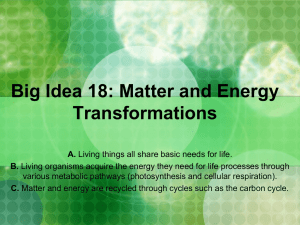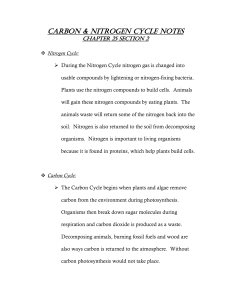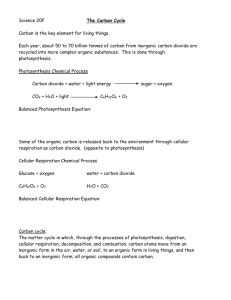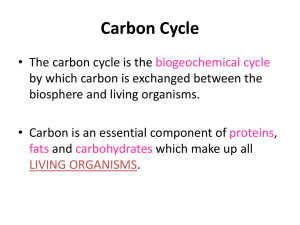Carbon in Nature DQC_diagnosis
advertisement
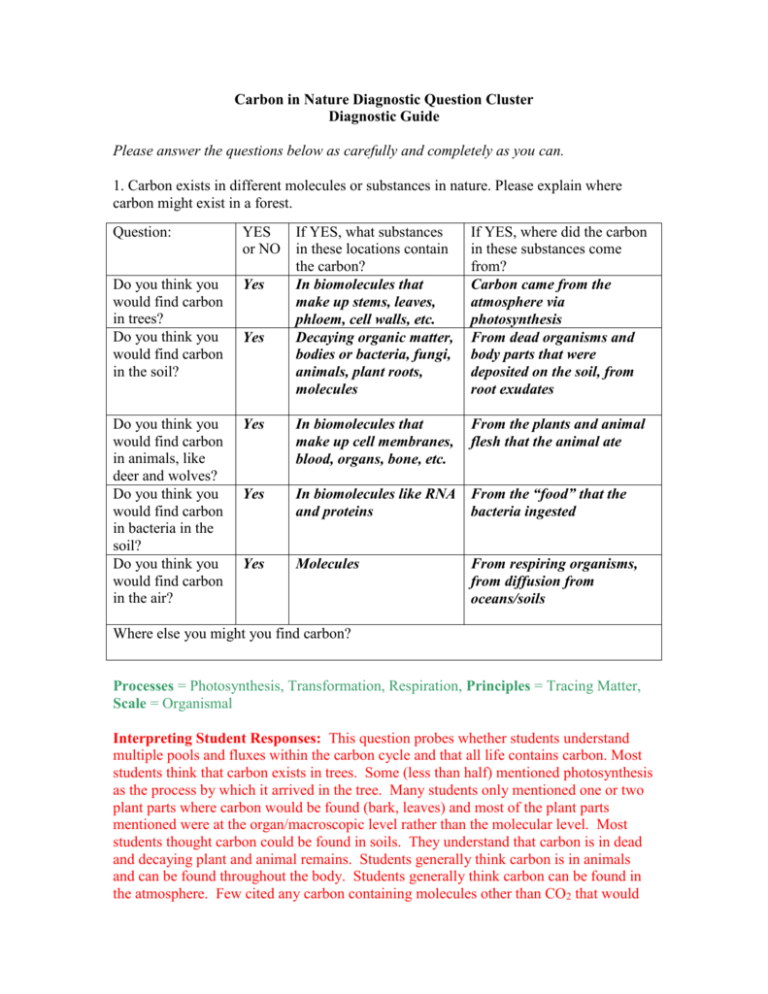
Carbon in Nature Diagnostic Question Cluster Diagnostic Guide Please answer the questions below as carefully and completely as you can. 1. Carbon exists in different molecules or substances in nature. Please explain where carbon might exist in a forest. Question: YES or NO If YES, what substances in these locations contain the carbon? In biomolecules that make up stems, leaves, phloem, cell walls, etc. Decaying organic matter, bodies or bacteria, fungi, animals, plant roots, molecules If YES, where did the carbon in these substances come from? Carbon came from the atmosphere via photosynthesis From dead organisms and body parts that were deposited on the soil, from root exudates Do you think you would find carbon in trees? Do you think you would find carbon in the soil? Yes Do you think you would find carbon in animals, like deer and wolves? Do you think you would find carbon in bacteria in the soil? Do you think you would find carbon in the air? Yes In biomolecules that make up cell membranes, blood, organs, bone, etc. From the plants and animal flesh that the animal ate Yes In biomolecules like RNA From the “food” that the and proteins bacteria ingested Yes Molecules Yes From respiring organisms, from diffusion from oceans/soils Where else you might you find carbon? Processes = Photosynthesis, Transformation, Respiration, Principles = Tracing Matter, Scale = Organismal Interpreting Student Responses: This question probes whether students understand multiple pools and fluxes within the carbon cycle and that all life contains carbon. Most students think that carbon exists in trees. Some (less than half) mentioned photosynthesis as the process by which it arrived in the tree. Many students only mentioned one or two plant parts where carbon would be found (bark, leaves) and most of the plant parts mentioned were at the organ/macroscopic level rather than the molecular level. Most students thought carbon could be found in soils. They understand that carbon is in dead and decaying plant and animal remains. Students generally think carbon is in animals and can be found throughout the body. Students generally think carbon can be found in the atmosphere. Few cited any carbon containing molecules other than CO2 that would be found in the atmosphere. When asked what “form” carbon would be in, many students gave vague answers like “air” and “atmosphere” 2. Draw arrows to explain how food moves through a green plant. Explain what the plant’s food is, and where it comes from. Arrows should point downward, from the leaves down to the stem and/or roots. The plant’s food is glucose that is created in the leaves through the process of photosynthesis. The glucose is made from carbon dioxide from the atmosphere and water from the soil, both of which meet in the leaves for the process. Processes = Photosynthesis, Transformation, Principles = Tracing Matter, Scale = Organismal Interpreting Student Responses: In order to answer this question, students need to understand what food is, where it is created, and that food moves from where it is created to where it is used. Students may provide answers that show they do not understand what food is and that photosynthesis is the process that creates food. 3a. What would happen to the carbon cycle if all decomposers suddenly died and were not replenished? Decide whether each statement is true (T) or false (F). T F Carbon would accumulate in organic matter. T F There would be more carbon in the soil for plants to absorb. T F Carbon would cycle more rapidly without decomposers. T F Carbon in the atmosphere would increase. 3b. Circle all correct answers. The reason for my responses are that … A) plants get their carbon from soil through their roots. B) decomposers serve as a “sink” for carbon and hold it in reserve. C) with no decomposers the carbon isn’t released as CO2. D) with one less segment of the food web, carbon would cycle faster. E) None apply; I wrote my reason to the right of the question. Processes = Respiration, Principles = Tracing Matter, Scale = Ecosystem Interpreting Student Responses: This question assesses student understanding of the role of decomposers in the carbon cycle. To correctly answer, they must trace carbon into and out of decomposers. Students who think that there would be more carbon in the soil for plants to absorb do not know where carbon enters a plant. Students who think that carbon would cycle more rapidly without decomposers do not know that decomposers release carbon dioxide to the atmosphere and release nutrients into the soil. Without the decomposers, organisms that die without being eaten by a consumer and waste would remain in its organic form in the soil. Students who think that carbon in the atmosphere would increase are not accounting for the various processes that remove and replenish carbon dioxide in the atmosphere. Without decomposers, less carbon dioxide would be added. 4. Organisms higher in a food web: A) eat everything that is lower on the food web. B) eat organisms directly below them in the food web, but not lower than that. C) eat only some species directly below them in the food web, but not lower than that. D) eat only some species directly below them in the food web and some others lower in the food web as well. Please explain your answer. Organisms that are higher in the food web often consume many organisms in lower trophic levels, not just in the trophic level immediately below them. For example, a coyote may eat an herbivore such as a rabbit, but may also eat an insect eating bird, which is a carnivore. Processes = Transformation, Principles = Tracing Matter, Scale = Ecosystem Interpreting Student Responses: This question assesses student understanding of food webs. Some students believe that organisms eat only species directly below them on the food web. Some students don’t recognize that an organism’s diet is restricted by more than just its trophic level. 5. Explain how increased carbon dioxide in the atmosphere might affect the grasses growing on a soccer field. Processes = Photosynthesis, Principles = Tracing Matter, Scale = Ecosystem Interpreting Student Responses: This question requires students to know that photosynthesis is the process by which plants generate organic carbon for growth, that carbon dioxide is a reactant for photosynthesis, and that plants get carbon dioxide from the atmosphere,. Some students may say that atmospheric carbon dioxide doesn’t affect plant growth because plants get carbon for photosynthesis from the soil or they may not know that carbon dioxide is a reactant for photosynthesis. Some students may give more sophisticated answers about the mechanism by which increased carbon dioxide affects photosynthesis at that cellular level. Some students may give more sophisticated answers about how increased carbon dioxide could indirectly affect photosynthesis via effects of climate change on the water cycle. 6. Carbon exists in the atmosphere, where could it have come from? Circle all correct answers. A) Photosynthesis by plants B) Diffusion from the ocean C) Cellular respiration by plants D) Cellular respiration by animals E) Cellular respiration by bacteria F) Photosynthesis by fungi G) Burning of biofuels H) Burning of fossil fuels I) Depletion of the ozone layer Processes = Photosynthesis, Respiration, Principles = Tracing Matter, Scale = Ecosystem Interpreting Student Responses: This question assesses whether students understand that carbon enters the atmosphere from a variety of sources and processes. It also assesses whether students have specific omissions/misconceptions about gasses entering and exiting the atmosphere. A) Student who do not know the correct reactants and products of photosynthesis may think that plants release CO2 into the atmosphere via photosynthesis. B) Many students do not recognize that there is gas exchange between the oceans and the atmosphere. This is a topic rarely addressed in introductory texts. C/D) Students who fail to continue to trace carbon after it enters the plant may think that plants and/or animals don’t respire. E) Students think bacteria don’t eat or respire. Students commonly do not recognize that the same process that occurs in animals and plants could also occur in single-celled organisms. F) Students who chose this answer may think that fungi are autotrophs AND that carbon dioxide is a product of photosynthesis. G/H) The majority of students recognize that burning of fossil fuels releases carbon to the atmosphere, but do not see that biofuels are also a source of carbon in the atmosphere. I) Some students think that the depletion of the ozone layer is related to the carbon cycle in a direct way. They are not accounting for the specific atoms in ozone. They may not know what ozone is made of or they may think that oxygen can become carbon.
